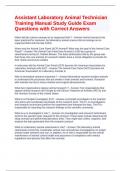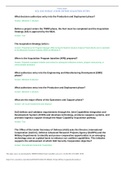Assistant Laboratory Animal Technician
Training Manual Study Guide Exam
Questions with Correct Answers
When did lab science emerge as an organized field ? - Answer-Animal research has
been practiced for centuries, but laboratory animal science did not emerge as an
organized field until the late 1940s
When was the Animal Care Panel (ACP) formed? What was the goal of the Animal Care
Panel? - Answer-The Animal Care Panel was formed in 1950 by a group of
veterinarians led by Dr. Nathan Brewer. The basic philosophy held by the group was
that those who use animals for research studies have a moral obligation to provide for
their needs and ensure welfare
In what year did the Animal Care Panel (ACP) become the American Association for
Laboratory Animals (AALAS)? - Answer-The Animal Care Panel (ACP) became the
American Association for Laboratory Animals in
Why is biomedical research important ? - Answer-Biomedical research studies animals
to understand the processes that are similar in both animals and humans. Research
with animals has led to many medical and surgical advancements
What two organizations oppose animal research ? - Answer-Two organizations that
oppose animal research are People for the Ethical Treatment of Animals (PETA) and
the Humane Society of the United States
What is a Principle Investigator (PI)? - Answer-A principle investigator is the scientist
who plans and coordinates all phases of the research work. The PI, co-investigators,
and research technicians perform the experiment and interpret the data. The PI is
responsible for reporting the research findings to the scientific community
What is a co-investigator's role ? - Answer-Co-investigators and research technicians
perform the specific tasks required for the protocol. These tasks include observing the
study animals and performing laboratory tests. They might also collect, organize, and
analyze the data generated from the research protocol
What is a laboratory animal veterinarian's role? - Answer-The laboratory animal
veterinarian commonly coordinates animal care and advises investigations on proper
animal model selection and use. In addition, he or she is responsible for the overall
maintenance of animal colony health and assurance of compliance with various
regulations and policies that affect the animals
,What are some laboratory animal technician's responsibilities? - Answer-Animal
technicians perform many animal care functions critical to the maintenance of healthy
animals. They can control factors that may affect research data. Something as simple
as a change in cleaning schedule, sanitization procedures, feed and bedding, humidity,
heat, light, or noise can cause problems. Animal technicians should make sure animals
get proper medical care by alerting veterinary staff when abnormalities are noted. They
must report to their supervisors and principal investigators all information on
environmental changes, changes in animal handling methods and errors in the
performance of day-to-day husbandry tasks
What are the responsibilities of an assistant laboratory animal technician? - Answer-
Assistant laboratory animal technicians are entry-level positions and perform important
daily tasks of animal husbandry. They commonly work under the supervision of a
veterinarian, technologist, supervisor, or facility manager. ALATs should understand the
moral and ethical aspects of the care and use of animals. ALATs are often the first to
recognize and report problems concerning individual animals, such as illness or
inappropriate housing, or small changes in the environmental conditions of an animal
room
What are some of the tasks that Assistant Laboratory Animal Technicians should be
able to complete? - Answer-Assistant Laboratory Animal Technicians should be able to:
- Handle routine husbandry tasks, such as feeding, watering, and bedding changes
- Perform sanitization and sterilization procedures used in animal facilities
- Observe and report changes in temperature, air exchange rate, light: dark cycles, and
humidity in the animal room environment
- Handle, restrain, and determine the sex of common laboratory animals
- Use various methods of animal identification
- Engage in accurate recordkeeping
- Recognize common signs of clinical illness and notes changes in eating habits, stool
and urine, or behavior
- Provide routine treatments, such as administering medications or clipping overgrown
toenails
What is the importance of accurate records when recordkeeping? - Answer-Accurate
records are vital to research programs and facility functions. Improper cage or animal
identifications, for example, could disrupt progress to research efforts and invalidate
results. Accurate up-to-date records also provide valuable information about the
animals' heath, caging and environment, medical care, and identification
What are the responsibilities of a Laboratory Animal Technologist? - Answer-Laboratory
animal technicians must maintain a current knowledge of husbandry methods, research
methodology, and the humane treatment of animals. Depending on the facility, LATs
may be assigned daily tasks related to animal husbandry, records, diagnostics,
materials and supplies, training, and first-level supervision
,When was the earliest law to protect animals from cruelty in America passed? Where
was it passed? - Answer-The earliest law to protect animals from cruelty in America was
passed in 1641 in the Massachusetts colony
When was the first federal anti-cruelty law enacted? - Answer-The first federal anti-
cruelty law was enacted in 1873
What is the function of the "Guide for the Care and Use of Laboratory Animals"? -
Answer-The purpose of the "Guide" is to assist institutions in caring for and using
animals in research. The "Guide" is the primary source of the standards and guidelines
for laboratory animal and use in the United States. The "Guide"' standards and
guidelines support good science through the humane use of animal facilities
What are some components for animal care and use of animals in animal facilities
included in the "Guide"? - Answer-The "Guide" describes standards for the following
components of an animal care and use program:
- personnel qualifications
- occupational health and safety
- animal environment, housing, and management
- veterinary care
- animal procurement and transportation
- surgical and postsurgical care
- alleviation of pain and distress
- euthanasia
- physical plant design and construction
When did congress pass the first federal law for laboratory animal welfare? What did
this law establish? - Answer-In 1966, the United States Congress enacted the first
federal law for laboratory animal welfare, the Animal Welfare Act (AWA). This law
established legal standards for laboratory animal care and use
What are some of the requirements of the Animal Welfare Act? - Answer-The Animal
Welfare Act (AWA) requires that minimum standards of care and treatment be provided
for covered animals bred for commercial sale, used in research, transported
commercially, or exhibited to the public
What is the purpose of Animal Welfare Regulations (AWR)? - Answer-The Animal
Welfare Regulations (AWR) are published each year in the Code of Federal
Regulations. The AWR define the roles of the different individuals in the animal facility.
The AWR also describes what a facility must do in order to comply with the AWA. The
AWR are administered by the Animal and Plant Inspection Service of the United States
Department of Agriculture (USDA)
In what year was an amendment made to the Animal Welfare Act? What was included
in the amendment? - Answer-A 1985 amendment to the Animal Welfare Act requires
that each registered institution have an Institutional Animal Care and Use Committee
, (IACUC). The IACUC has become responsible for ensuring that the animal research
program is in compliance with all applicable laws, policies, and guidelines
What is the responsibility of the United States Department of Agriculture (USDA)'s
Animal and Plant Health Inspection Service (APHIS)? - Answer-The USDA's Animal and
Plant Health Inspection Service (APHIS) is charged with administering and enforcing
the Animal Welfare Regulations. To ensure compliance, an APHIS inspector conducts
unannounced site visits at least annually to inspect the facility. The inspector looks at
the animal species covered under the AWA and the relevant animal records. The
inspector also reviews the IACUC's semi-annual facility inspection reports and the
records of its program reviews. The inspector then issues a report. Any violation noted
on the inspector's report must be corrected
What are the responsibilities of the Public Health Service Policy (PHS)? What is
covered by the Public Health Service Policy? - Answer-The Public Health Service Policy
on Humane Care and Use of Laboratory Animals requires institutions to ensure the
appropriate care and use of all animals involved in PHS-conducted or supported
research. The PHS Policy covers all live vertebrates used or intended for use in
research, research training, experimentation, biological testing, or for related purposes
Who is responsible for the general administration and coordination of the Public Health
Service Policy? - Answer-The Office of Laboratory Animal Welfare (OLAW) at NIH is
responsible for the general administration and coordination of the PHS Policy. The IO
must submit a document called the Animal Welfare Assurance of Compliance
Statement to OLAW, which describes the institution's program for the care and use of
animals
What are the steps of the Animal Use Protocol? - Answer-1. The IACUC approves all
work with vertebrate animals at the institution by reviewing each animal use protocol.
The protocol is a standard form developed by the institution. A PI uses the protocol to
describe and justify the proposed studies
2. The IACUC members carefully review the protocol. The protocol must be approved
by the IACUC before the research can be initiated
3. Approved protocols are typically assigned an ID number based on a numbering
scheme of the institution. The protocol number is typically displayed on cage cards and
other animals documents, such as health records. Animal technicians must be aware
that each animal is counted on a specific protocol
What are the US Government Principles for the Utilization and Care of Vertebrate
Animals Used in Testing, Research, and Training ? - Answer-The US Government
Principles for the Utilization and Care of Vertebrate Animals Used in Testing, Research,
and Training, also commonly known as the "US Government Principles", were principles
incorporated into the PHS policy. They apply to all vertebrate species and to all studies
receiving support from any federal agency





